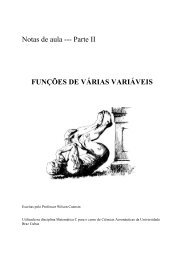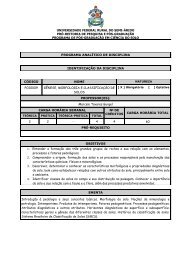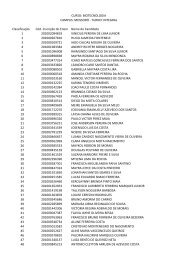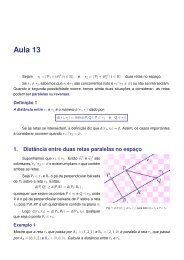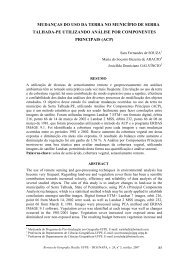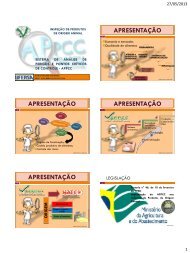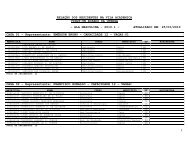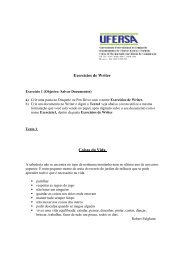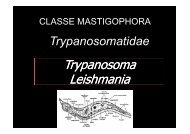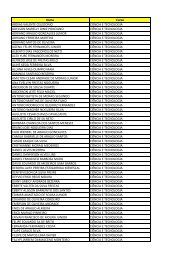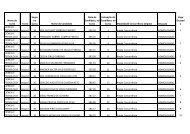Injectable Anesthesia and Analgesia of Birds by J. Paul ... - Ufersa
Injectable Anesthesia and Analgesia of Birds by J. Paul ... - Ufersa
Injectable Anesthesia and Analgesia of Birds by J. Paul ... - Ufersa
You also want an ePaper? Increase the reach of your titles
YUMPU automatically turns print PDFs into web optimized ePapers that Google loves.
caused regurgitation <strong>and</strong> tenesmus in budgerigars [43]. The most serious complication <strong>of</strong> flunixin meglumide in birds is renal<br />
ischemia. Bobwhite quail experimentally given daily intramuscular injections <strong>of</strong> flunixin meglumide for 7 days had<br />
histological evidence <strong>of</strong> renal damage in all birds, even at doses as low as 0.1 mg/kg. Severity <strong>of</strong> the lesions was directly<br />
correlated to the dose <strong>of</strong> flunixin meglumide with acute necrotizing glomerulitis, tophi in the renal tubules <strong>and</strong> visceral gout<br />
occurring at 32 mg/kg [50]. Renal ischemia <strong>and</strong> necrosis has been documented in Siberian cranes treated with flunixin<br />
meglumide (5 mg/kg) for muscle <strong>and</strong> skeletal trauma [51]. The use <strong>of</strong> flunixin meglumide currently is contraindicated in<br />
cranes <strong>and</strong> used with great caution with other avian species.<br />
Piroxicam is used in mammals to treat chronic inflammatory conditions such as arthritis. It as been used to treat chronic<br />
degenerative joint disease in cranes <strong>and</strong> other species <strong>of</strong> birds <strong>and</strong> appears to provide mild to moderate improvement <strong>and</strong><br />
willingness to bear weight on affected limbs over extended treatment periods.<br />
Drug Dosage (Dose), Route Species / Remarks Reference<br />
Atipamezole<br />
182 - 281 mg/kg (250 mg<br />
dose), IV<br />
Mallard ducks: to reverse medetomidine; rapidly regained<br />
consciousness, struggled & flapped wings; tachycardia <strong>and</strong><br />
tachypnea observed.<br />
Machin<br />
[21]<br />
0.2 mg/kg, IV; <strong>and</strong> 0.2<br />
mg/kg, SC<br />
Ostriches: to reverse medetomidine; half <strong>of</strong> the total 0.4<br />
mg/kg dose was given IV, the other half SC; recovery was<br />
smooth <strong>and</strong> ranged from ~14 - 28 min<br />
Langan<br />
[22]<br />
3.75 - 10 mg/kg<br />
Pigeons (Columbia livia) <strong>and</strong> Amazon Parrots (Amazona<br />
spp.): Used to reverse medetomidine; the dose given was<br />
2.5 or 5 times the medetomidine dose administered. No<br />
differences were seen between the higher <strong>and</strong> lower doses.<br />
Recovery was smooth <strong>and</strong> rapid; st<strong>and</strong>ing times were all<br />
within 4 min<br />
S<strong>and</strong>meier<br />
[18]<br />
0.25 - 1.0 mg/kg<br />
Various avian species: Recommends a dose 5 times that <strong>of</strong><br />
medetomidine to reverse its effects.<br />
Jalanka<br />
[52]<br />
0.5 - 2.5 mg/kg<br />
Various avian species: Recommends a dose 5 times that <strong>of</strong><br />
medetomidine to reverse its effects.<br />
Berthier<br />
[53]<br />
Atipamezole (A) /<br />
Diprenorphine (D)<br />
Atipamezole (A)<br />
Flumazenil (F)<br />
(A) 40 - 161 mg/kg (5 - 20<br />
mg dose)<br />
(D) 12 - 20 mg/kg (15 - 25<br />
mg dose), IV<br />
(A) 182 - 281 mg/kg (250<br />
mg dose)<br />
(F) 18 - 28 mg/kg (25 mg<br />
dose), IV<br />
Red-necked ostriches (Struthio camelus): to reverse<br />
meditomidine/etorphine combination; lead to a fast but<br />
violent recovery.<br />
Mallard ducks: to reverse medetomidine/midazolam,<br />
respectively; rapidly regained consciousness, struggled &<br />
flapped wings; tachycardia <strong>and</strong> tachypnea observed.<br />
Ostrowski<br />
[33]<br />
Machin<br />
[21]<br />
Atropine 0.006 mg/kg, IV Ratite; used to treat bradycardia. Lin [30]<br />
Butorphanol (B)<br />
1 - 2 mg/kg, IM<br />
African grey parrots (Psittacus erithacus): 6/11 birds had<br />
an increased pain threshold to a noxious electrical stimulus<br />
after administration <strong>of</strong> 1 mg/kg B (this may represent the<br />
ED 50<br />
for the drug); higher dosages such as 2 - 3 mg/kg have<br />
been used to treat pain in subsequent studies without<br />
adverse side effects (unpublished findings).<br />
Cockatoos (Cacatua spp.): reduced is<strong>of</strong>lurane requirement<br />
in cockatoos; heart rate was reduced <strong>by</strong> 12%; apnea was<br />
not observed; respiratory rate increased <strong>by</strong> 77%, while tidal<br />
volume decreased <strong>by</strong> 25%, thus having no significant net<br />
effect on minute ventilation.<br />
<strong>Paul</strong>-<br />
Murphy<br />
[41]<br />
1 mg/kg, IM<br />
Curro [38]<br />
1 mg/kg, IM<br />
Psittacines: significantly reduced is<strong>of</strong>lurane ED 50<br />
in<br />
cockatoos (Cacatua spp.) <strong>and</strong> African grey parrots<br />
(Psittacus erithacus), but had no affect on the is<strong>of</strong>lurane<br />
ED 50<br />
in blue-fronted Amazons(Amazona aestiva aestiva).<br />
Curro [39]



